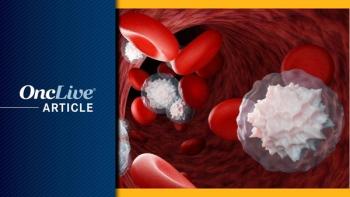
Giredestrant Shows Numerical PFS Benefit Vs Endocrine Monotherapy in ER+ Metastatic Breast Cancer
Giredestrant provided a numerical, but not statistically significant, improvement in progression-free survival over physician’s choice of endocrine therapy in patients with estrogen receptor–positive, HER2-negative, locally advanced or metastatic breast cancer, according to data from the phase 2 acelERA BC study.
Giredestrant (GDC-9545) provided a numerical, but not statistically significant, improvement in progression-free survival (PFS) over physician’s choice of endocrine therapy (PCET) in patients with estrogen receptor (ER)–positive, HER2-negative, locally advanced or metastatic breast cancer, according to data from the phase 2 acelERA BC study (NCT04576455).
Data presented at the 2022 ESMO Congress indicated that the median PFS with giredestrant (n = 151) was 5.6 months per investigator assessment vs 5.4 months with PCET (n = 152) in this patient population (HR, 0.81; 95% CI, 0.60-1.10; P = .1757). The 6-month PFS rates in the investigative and control arms were 46.8% and 39.6%, respectively.
A consistent treatment effect with giredestrant was observed across most subgroups evaluated, with a more pronounced effect observed in those whose tumors harbored ESR1 mutations. In this subset, the median PFS with giredestrant (n = 51) was 5.3 months vs 3.5 months with PCET (n = 39; HR, 0.60; 95% CI, 0.35-1.03; P = .0610).
“Overall, these data support the continued investigation of giredestrant in other studies,” lead study author Miguel Martin, of the Hospital Gregorio Maranon, Universidad Complutense, said in a presentation of the data.
The trial enrolled a total of 303 post- or pre-/perimenopausal patients with ER-positive/HER2-negative locally advanced, metastatic breast cancer. Patients were required to have previously received 1 or 2 lines of systemic therapy for their disease, including 1 endocrine therapy, up to 1 targeted therapy, and up to 1 chemotherapy agent.
Participants were randomly assigned 1:1 to receive oral giredestrant at 30 mg daily or PCET in the form of fulvestrant (Faslodex) or an aromatase inhibitor. Patients were stratified based on whether they had visceral or non-visceral disease, whether they had or had not received previous CDK4/6 inhibitors, or whether they had previous fulvestrant or not.
The key end points of the trial were investigator-assessed PFS by RECIST v1.1 criteria, overall survival, objective response rate (ORR), duration of response (DOR), clinical benefit rate (CBR), PFS by ESR1 mutational status, safety, and patient-reported outcomes.
In the total population, the median age was 60 years, with 99.7% of patients being female and 83% postmenopausal. Moreover, 52% of patients had an ECOG performance status of 0. Regarding race, 41% were Asian and 56% were White. Most patients were from Asia (40%) and Europe (37%) and had visceral (68%) or measurable (93%) disease.
Regarding prior treatment, 71% of patients received 1 prior line and 28% received 2 prior lines. Seventy-seven percent of patients received an aromatase inhibitor in the form of fulvestrant (19%) or tamoxifen (17%). Forty-two percent of patients received a CDK4/6 inhibitor, and 36% of patients received this kind of agent as their last prior line of therapy. Thirty-two percent of patients received chemotherapy; 24% received this modality as their last prior line of treatment.
Additional data showed that giredestrant elicited a confirmed ORR of 12.6% (95% CI, 7.75%-18.95%) vs 7.2% (95% CI, 3.67%-12.58%) with PCET (odds ratio [OR], 1.87; 95% CI, 0.86-4.07). The median DOR in the investigative and control arms were not yet reached (95% CI, 5.55–not evaluable [NE]) and 7.39 months (95% CI, 7.39-NE), respectively.
The clinical benefit rate with giredestrant was 31.8% (95% CI, 24.46%-39.85%) vs 21.1% (95% CI, 14.87%-28.40%) with PCET (OR, 1.79; 95% CI, 1.06-3.04).
Regarding safety, giredestrant was well tolerated. The safety profile of selective estrogen receptor degrader was comparable to that observed with PCET; the toxicities were consistent with the known risks that come with endocrine treatment.
Eighty-five percent of patients in the giredestrant arm experienced adverse effects (AEs) vs 71% of those in the PCET arm; these effects were grade 3 or 4 in 17% and 12% of patients, respectively. Grade 3 or 4 treatment-related AEs occurred in 4% of those in the investigative arm vs 3% of those in the control arm. Serious toxicities were reported in 9% and 8% of patients, respectively; serious TRAEs occurred in 2% and 1% of patients, respectively. One percent of patients in each arm experienced a grade 5 AE.
The most common treatment-emergent toxicities included hepatotoxicity, musculoskeletal pain, arthralgia, fatigue, nausea, diarrhea, vomiting, dizziness, hot flushes, bradycardia, renal toxicity, QT prolongation, and venous thromboembolism.
“Grade 3/4 TRAEs, serious AEs, and discontinuations due to AEs were balanced across the arms,” the study authors concluded.
Reference
Jimenez MM, Lim E, Mac Gregor MC, et al. Giredestrant (GDC-9545) vs physician choice of endocrine monotherapy (PCET) in patients (pts) with ER+, HER2– locally advanced/metastatic breast cancer (LA/mBC): primary analysis of the phase II, randomised, open-label acelERA BC study. Ann Oncol. 2022;33(suppl 7):S633-S634. doi:10.1016/j.annonc.2022.07.250

























































































